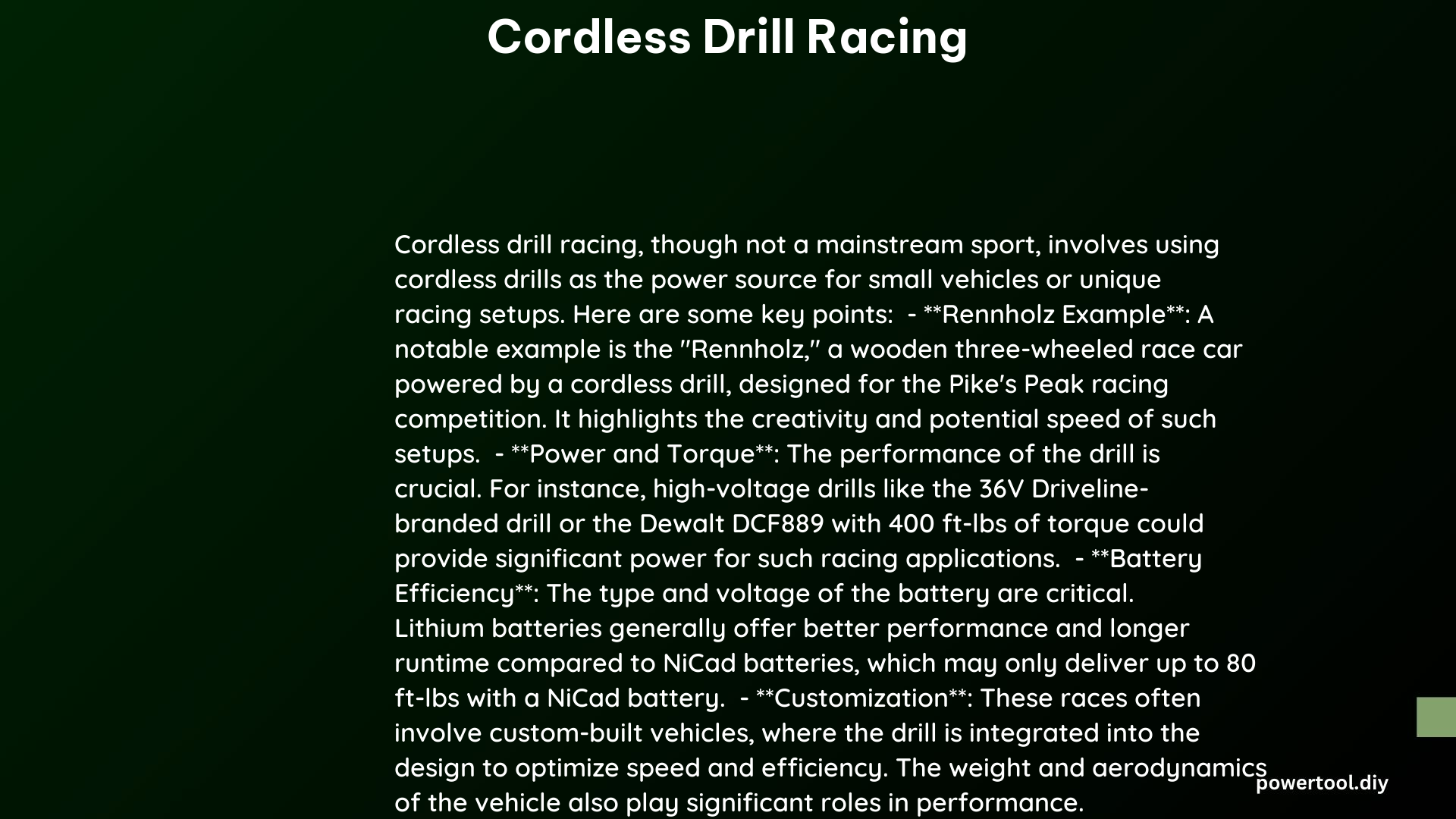Cordless drill racing is an emerging motorsport that combines engineering ingenuity with the thrill of competition. Participants modify standard cordless drills to achieve maximum speed and performance, racing them on specially designed tracks. This unique sport challenges competitors to optimize battery power, gear ratios, and motor efficiency while adhering to strict safety guidelines. From amateur enthusiasts to professional teams, cordless drill racing attracts a diverse community of power tool aficionados and engineers eager to push the limits of these everyday tools.
What is the History of Cordless Drill Racing?
Cordless drill racing emerged as a niche hobby in the early 2000s, primarily among DIY enthusiasts and engineers. The sport gained traction through online forums and social media, where participants shared their modifications and race results. As interest grew, organized events began to appear, first at maker fairs and trade shows, then evolving into dedicated racing leagues.
Key milestones in the sport’s development include:
- 2005: First documented informal race at a university engineering department
- 2008: Establishment of the International Cordless Drill Racing Association (ICDRA)
- 2012: Introduction of standardized track designs and race categories
- 2015: First televised cordless drill racing event
- 2019: Launch of the World Cordless Drill Racing Championship
How Does Cordless Drill Racing Work?

Cordless drill racing involves modifying standard cordless drills to achieve maximum speed and performance. Races typically take place on straight tracks ranging from 10 to 50 meters in length. Drills are mounted on custom-built chassis and guided by rails or grooves in the track.
The basic components of a racing drill include:
- Modified cordless drill
- Custom chassis or frame
- Wheels or rollers
- Steering mechanism (if applicable)
- Safety features (e.g., kill switch, protective casing)
Races are typically organized into heats, with multiple drills competing simultaneously. The winner is determined by the fastest time to complete the course or the highest top speed achieved.
What Are the Key Factors in Cordless Drill Performance?
Several factors contribute to the performance of a racing cordless drill:
- Motor Power: Higher voltage motors generally produce more power and speed.
- Battery Capacity: Larger capacity batteries (measured in mAh) provide longer run times.
- Gear Ratio: Optimized gear ratios balance speed and torque for maximum performance.
- Weight: Lighter drills accelerate faster but may sacrifice stability.
- Aerodynamics: Streamlined designs reduce air resistance.
- Cooling Systems: Efficient heat dissipation allows for sustained high performance.
How Are Cordless Drill Races Timed and Measured?
Accurate timing and measurement are crucial in cordless drill racing. Common methods include:
- Electronic Timing Gates: Infrared or laser beams detect when a drill crosses the start and finish lines.
- High-Speed Cameras: Used for photo finishes and speed measurements.
- Radar Guns: Measure top speeds during races.
- Telemetry Systems: Provide real-time data on drill performance, including speed, temperature, and battery voltage.
What Safety Measures Are Essential in Cordless Drill Racing?
Safety is paramount in cordless drill racing. Key safety measures include:
- Protective Gear: Racers and officials must wear safety glasses, gloves, and hearing protection.
- Track Barriers: Sturdy barriers prevent drills from leaving the track.
- Emergency Shut-off Systems: Remote kill switches allow immediate power cut in case of malfunction.
- Fire Safety Equipment: Fire extinguishers and safety blankets are mandatory at all events.
- Battery Containment: Reinforced casings prevent battery ejection or explosion.
How Can Beginners Get Started in Cordless Drill Racing?
For those interested in entering the world of cordless drill racing, here are some steps to get started:
- Research: Learn about the sport through online forums and videos.
- Acquire a Drill: Start with a standard 18V or 20V cordless drill.
- Basic Modifications: Begin with simple upgrades like improved batteries or motor brushes.
- Join a Club: Connect with local enthusiasts for advice and practice opportunities.
- Attend Events: Observe races to learn techniques and rules.
- Practice: Set up a small track at home to test and improve your drill’s performance.
What Are the Different Categories in Cordless Drill Racing?
Cordless drill racing features various categories to accommodate different skill levels and modification types:
| Category | Description | Max Voltage | Modifications Allowed |
|---|---|---|---|
| Stock | Unmodified drills | 20V | None |
| Modified | Limited upgrades | 24V | Battery, gears, motor brushes |
| Unlimited | No restrictions | None | Any modification |
| Junior | Youth division | 12V | Safety-approved mods |
| Team | Relay races | Varies | Category-dependent |
What Are the Most Common Modifications in Cordless Drill Racing?
Popular modifications to enhance drill performance include:
- Battery Upgrades: Higher capacity or voltage batteries for increased power and runtime.
- Motor Enhancements: Rewinding motors or replacing brushes for improved efficiency.
- Gear Ratio Changes: Custom gearboxes to optimize speed and torque.
- Weight Reduction: Removing non-essential components and using lightweight materials.
- Cooling Systems: Adding heat sinks or fans to prevent overheating.
- Aerodynamic Shells: Custom casings to reduce air resistance.
How Do Organizers Ensure Fair Competition in Cordless Drill Racing?
To maintain fair competition, organizers implement several measures:
- Technical Inspections: All drills undergo pre-race checks to ensure compliance with category rules.
- Standardized Tracks: Consistent track designs and surfaces across events.
- Weight Classes: Some events group drills by weight to level the playing field.
- Battery Limitations: Restrictions on battery capacity or chemistry in certain categories.
- Scrutineering: Post-race inspections of winning drills to verify compliance.
- Handicap Systems: Used in some events to allow drills of different capabilities to compete fairly.
By implementing these measures, cordless drill racing maintains its integrity as a competitive sport while encouraging innovation and skill development among participants.
